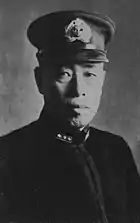
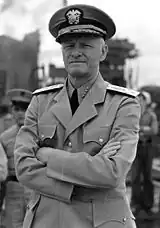
The Battle of the Eastern Solomons was fought August 23–25, 1942 in the waters east and northeast of the Solomon Islands by forces of the Imperial Japanese Navy's Combined Fleet and the US Navy's Pacific Fleet. The battle resulted from a major effort by the Japanese to reinforce their troop strength on the island of Guadalcanal. The Japanese high command had realized this reinforcement was necessary following the annihilation of the Ichiki Detachment by the 1st Marines a few days earlier.
The battle can be counted both a tactical and strategic American victory: greater ship losses were inflicted on the Japanese, and the transports were turned back from their mission of landing reinforcements.
Forces deployed
![]() Japanese forces
Japanese forces
- Combat ships: 2 fleet carriers, 1 light carrier, 3 old battleships, 13 heavy cruisers, 3 light cruisers, 30 destroyers, 2 1st-class submarines, 1 2nd-class submarine
- Aircraft: 69 fighters, 41 dive bombers, 57 torpedo bombers
![]() American forces
American forces
- Combat ships: 3 fleet carriers, 1 fast battleship, 5 heavy cruisers, 2 anti-aircraft light cruisers, 18 destroyers
- Aircraft: 100 fighters, 54 dive bombers, 54 scout bombers, 45 torpedo bombers
Ship losses
- IJN : 1 light carrier, 1 destroyer, 1 1st-class submarine
- USN : none
Japanese order of battle
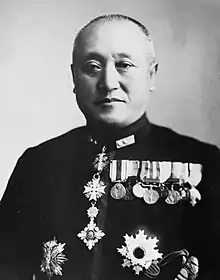
.jpg.webp)
Guadalcanal Supporting Forces
Vice Admiral Nobutake Kondo in heavy cruiser Atago[1]
- Advanced Force
- Vice Admiral Kondo
- Main Body
- Cruiser Division 4
- 3 Takao-class heavy cruisers (10 × 8-in. main battery):[lower-alpha 1] Atago, Maya, Takao
- Cruiser Division 5 (Vice Adm. Takeo Takagi)
- 2 Myoko-class heavy cruisers (10 × 8-in. main battery):[lower-alpha 2] Myoko, Haguro
- Destroyer Squadron 4 (Rear Adm. Tamotsu Takama):
- 1 Nagara-class light cruiser (7 × 5.5-in. main battery): Yura
- 2 Asashio-class destroyers (6 × 5-in. main battery): Asagumo, Yamagumo
- 3 Kagero-class destroyers (6 × 5-in. main battery): Kuroshio, Oyashio, Hayashio
- Cruiser Division 4
- Main Body
- Support Group
- 1 Nagato-class battleship (8 × 16-in. main battery):[lower-alpha 3] Mutsu
- 3 Shiratsuyu-class destroyers (5 × 5-in. main battery): Murasame, Harusame, Samidare
- Support Group

.jpg.webp)


- Striking Force
- Vice Admiral Chuichi Nagumo in fleet carrier Shokaku
- Carrier Group
- Vice Admiral Nagumo
- 2 Shōkaku-class fleet carriers
- Shōkaku (Capt. Masafumi Arima)
- 27 Mitsubishi A6M "Zeke" fighters (Lt. Hideki Shingo)
- 27 Aichi D3A "Val" dive bombers (Lt. Cdr. Mamoru Seki)
- 18 Nakajima B5N "Kate" torpedo bombers (Lt. Cdr. Shigeharu Murata)
- Zuikaku (Capt. Tameteru Notomo)
- 27 Mitsubishi A6M "Zeke" fighters (Lt. Ayao Shirane)
- 27 Aichi D3A "Val" dive bombers (Lt. Sadamu Takahashi)
- 18 Nakajima B5N "Kate" torpedo bombers (Lt. Shigeichirō Imajuku)
- Shōkaku (Capt. Masafumi Arima)
- Screen
- 1 Kagero-class (6 × 5-in. main battery): Akigumo
- 3 Yugumo-class (6 × 5-in. main battery): Yugumo, Makigumo, Kazegumo
- 2 Fubuki-class (6 × 5-in. main battery): Shikinami, Uranami
- 2 Shōkaku-class fleet carriers
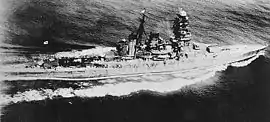
- Vanguard Group
- Rear Admiral Hiroaki Abe
- Battleships
- 2 Kongo-class fast battleships (8 × 14-in. main battery):[lower-alpha 4] Hiei, Kirishima
- Cruiser Division 7 (Rear Adm. Shoji Nishimura)
- 2 Mogami-class (10 × 8-in. main battery):[lower-alpha 5] Kumano, Suzuya
- 1 Tone-class (8 × 8-in. main battery):[lower-alpha 6] Chikuma
- Destroyer Squadron 10 (Rear Admiral Susumu Kimura)
- 1 Nagara-class light cruiser (7 × 5.5-in. main battery): Nagara
- 1 Akizuki-class destroyer (8 × 4-in. main battery): Akizuki
- 5 Kagero-class destroyer (6 × 5-in. main battery): Hatsukaze, Maikaze, Nowaki, Tanikaze, Yukikaze
- Battleships

- Diversionary Group
- Rear Admiral Chūichi Hara in heavy cruiser Tone
- 1 light carrier: Ryujo (Capt. Tadao Katō) (sunk)
- 24 Mitsubishi A6M "Zeke" fighters (Lt. Kenjirō Nōtomi)
- 9 Nakajima B5N "Kate" torpedo bombers (Lt. Binichi Murakami)
- 1 Tone-class heavy cruiser (8 × 8-in. main battery):[lower-alpha 7] Tone
- 2 Kagero-class destroyers (6 × 5-in. main battery): Amatsukaze, Tokitsukaze
- 1 light carrier: Ryujo (Capt. Tadao Katō) (sunk)
Southeast Area Forces
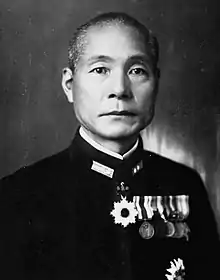



Vice Admiral Nishizo Tsukahara
- Outer South Seas Force
- Vice Admiral Gunichi Mikawa
- Reinforcement Group
- Rear Admiral Raizo Tanaka[lower-alpha 8]
- Transport Unit
- 1 auxiliary cruiser: Kinryu Maru
- Embarking 800 men of the 5th Yokosuka SNLF
- 4 patrol boats: No. 1, No. 2, No. 34, No. 35
- Embarking 700 men of the 2nd echelon of the IJA Ichiki Detachment
- 1 auxiliary cruiser: Kinryu Maru
- Escort Unit
- 1 Sendai-class light cruiser (7 × 5.5-in. main battery, 1 scout plane): Jintsu
- 2 Kagero-class destroyers (6 × 5-in. main battery): Kagero, Isokaze
- 3 Shiratsuyu-class destroyers (5 × 5-in. main battery): Kawakaze, Suzukaze, Umikaze
- 3 Mutsuki-class destroyers (4 × 4.7-in. main battery): Mutsuki (sunk), Yayoi, Uzuki
- Transport Unit
- Covering Group
- Vice Admiral Mikawa[lower-alpha 9]
- 1 Takao-class heavy cruiser: Chōkai[4]
- Cruiser Division 6 (Rear Adm. Aritomo Gotō)
- 2 Aoba-class heavy cruisers (6 × 8-in. main battery):[lower-alpha 10] Aoba, Kinugasa
- 1 Furutaka-class heavy cruiser (6 × 8-in. main battery):[lower-alpha 11] Furutaka
American order of battle
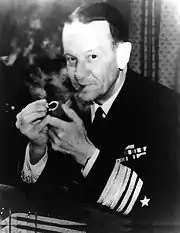
_8_Feb_1944.jpg.webp)
Task Force 61
Vice Admiral Frank Jack Fletcher in Saratoga[5]
Task Force 11
Vice Admiral Fletcher
- 1 Lexington-class fleet carrier
- Saratoga (Capt. DeWitt C. Ramsey)
- Air Group (Cmdr. Harry D. Felt)
- VF-5: 27 F4F Wildcat fighters (Lt. Cmdr. Leroy C. Simpler)
- VB-3: 17 SBD Dauntless dive bombers (Lt. Cmdr. Dewitt W. Shumway)
- VS-3: 15 SBD Dauntless scout bombers (Lt. Cmdr. Louis J. Kirn)
- VT-8: 13 TBF Avenger torpedo bombers (Lt. Harold H. Larsen)
- Air Group (Cmdr. Harry D. Felt)
- Saratoga (Capt. DeWitt C. Ramsey)
- Cruisers (Rear Adm. Carleton H. Wright)
- 2 New Orleans-class heavy cruisers (9 × 8-in./55-cal. main battery)
- Minneapolis (Capt. Frank J. Lowry)
- New Orleans (Capt. Walter S. DeLany)
- 2 New Orleans-class heavy cruisers (9 × 8-in./55-cal. main battery)
- Screen (Capt. Samuel B. Brewer)
- 5 destroyers
- 1 Porter-class (8 × 5-in./38 SP/low elevation main battery): Phelps
- 4 Farragut-class (4 × 5-in./38 DP main battery): Farragut, MacDonough, Worden, Dale
- 5 destroyers
Task Force 16
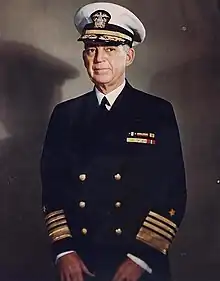
_underway_c1943.jpg.webp)
Rear Admiral Thomas C. Kinkaid in Enterprise
- 1 Yorktown-class fleet carrier
- Enterprise (Capt. Arthur C. Davis)
- Air Group (Lt. Cmdr. Maxwell F. Leslie)
- VF-6: 29 F4F Wildcat fighters (Lt. Louis H. Bauer)
- VB-6: 17 SBD Dauntless dive bombers (Lt. Ray Davis)
- VS-5: 18 SBD Dauntless scout bombers (Lt. Turner F. Caldwell)
- VT-3: 15 TBF Avenger torpedo bombers (Lt. Cmdr. Charles M. Jett)
- Air Group (Lt. Cmdr. Maxwell F. Leslie)
- Enterprise (Capt. Arthur C. Davis)
- Battleship and Cruisers (Rear Adm. Mahlon S. Tisdale)
- 1 North Carolina-class fast battleship (9 × 16-in./45-cal. main battery)
- North Carolina (Capt. George H. Fort)
- 1 Portland-class heavy cruiser (9 × 8-in./55-cal. main battery)
- Portland (Capt. Laurance T. DuBose)
- 1 Atlanta-class anti-aircraft light cruiser (16 × 5-in./38-cal. main battery)[lower-alpha 12]
- Atlanta (Capt. Samuel P. Jenkins)
- 1 North Carolina-class fast battleship (9 × 16-in./45-cal. main battery)
- Screen (Capt. Edward P. Sauer)
- 6 destroyers
- 1 Porter-class (8 × 5-in./38 SP/low elevation main battery): Balch
- 2 Gleaves-class (5 × 5-in. dual purpose main battery): Grayson, Monssen
- 1 Gridley-class (4 × 5-in./38 dual purpose main battery): Maury
- 2 Benham-class (4 × 5-in./38 dual purpose main battery): Benham, Ellet
- 6 destroyers
Task Force 18 (deployed but did not take part in battle)

_entering_Hampton_Roads_on_26_May_1942.jpg.webp)
Rear Admiral Leigh Noyes in Wasp
- 1 Wasp-class fleet carrier
- Wasp (Capt. Forrest P. Sherman)
- Air Group (Lt. Cmdr. Wallace M. Beakley)
- VF-71: 28 F4F Wildcat fighters (Lt. Cmdr. Courtney Shands)
- VS-71: 18 SBD Dauntless scout bombers (Lt. Cmdr. John Eldridge)
- VS-72: 18 SBD Dauntless scout bombers (Lt. Cmdr. Ernest M. Snowden)
- VT-7: 15 TBF Avenger torpedo bombers (Lt. Henry A. Romberg)
- Air Group (Lt. Cmdr. Wallace M. Beakley)
- Wasp (Capt. Forrest P. Sherman)
- Cruisers (Rear Adm. Norman Scott)[lower-alpha 13]
- 1 Pensacola-class heavy cruiser (10 × 8-in. main battery)
- Salt Lake City (Capt. Charles H. McMorris)
- 1 New Orleans-class heavy cruiser (9 × 8-in. main battery)
- San Francisco (Capt. Ernest G. Small)
- 1 Atlanta-class anti-aircraft light cruiser (16 × 5-in. main battery)[lower-alpha 12] S
- San Juan (Capt. James E. Maher)
- 1 Pensacola-class heavy cruiser (10 × 8-in. main battery)
- Screen (Capt. Robert G. Tobin)
- 7 destroyers
- 1 Porter-class (8 × 5-in. main battery): Selfridge
- 2 Gleaves-class (5 × 5-in. main battery): Aaron Ward, Buchanan
- 3 Benham-class (4 × 5-in. main battery): Lang, Stack, Sterett
- 1 Benson-class (4 × 5-in. main battery): Farenholt
- 7 destroyers
Individual attack waves
Attack on Enterprise (Nagumo carrier group 1st wave)
- 10 Mitsubishi A6M "Zeke" fighters: 4 from Shokaku, 6 from Zuikaku
- 27 Aichi D3A "Val" dive bombers: 18 from Shokaku, 9 from Zuikaku[6]
Nagumo carrier group 2nd wave (found no targets)
- 9 Mitsubishi A6M "Zeke" fighters: 3 from Shokaku, 6 from Zuikaku
- 27 Aichi D3A "Val" dive bombers: 9 from Shokaku, 18 from Zuikaku[6]
Ryūjō Attack on Henderson Field
- 6 Nakajima B5N "Kate" torpedo bombers: all from Ryūjō
- 14 Mitsubishi A6M "Zeke" fighters: all from Ryūjō[7]
B-17 strike on Nagumo carrier group
- TBD
Saratoga strike on Ryūjō
- TBD
B-17 strike on Ryūjō
- TBD
Notes
- ↑ Each ship also carried 3 scout planes.
- ↑ Each ship also carried 2 scout planes.
- ↑ Ship also carried 3 scout planes.
- ↑ Each ship also carried 2 scout planes.
- ↑ Each ship also carried 3 scout planes.
- ↑ Ship also carried 6 scout planes.
- ↑ Ship also carried 6 scout planes.
- ↑ Departed Truk 16 August[2]
- ↑ Departed Shortlands 23 August.[3]
- ↑ Each ship also carried 2 scout planes.
- ↑ Ship also carried 2 scout planes.
- 1 2 These cruisers were intended as destroyer leaders when designed. After the first two to be used in this role, Atlanta and Juneau, were lost at the Naval Battle of Guadalcanal, this mission was abandoned and the anti-aircraft mission adopted.[lower-alpha 14]
- ↑ Killed three months later at the Naval Battle of Guadalcanal.
- Stille 2016, p. 7.
References
- ↑ Morison 1948, pp. 84–85.
- ↑ "Japanese Auxiliary Cruisers".
- ↑ "Imperial Cruisers".
- ↑ "Imperial Cruisers".
- ↑ Morison 1948, pp. 86–87.
- 1 2 "Imperial Flattops".
- ↑ "Kido Butai". Combinedfleet.com. Retrieved June 4, 2023.
Bibliography
- Lundstrom, John B. (2005). First Team and the Guadalcanal Campaign: Naval Fighter Combat from August to November 1942 (New ed.). Annapolis, Maryland: Naval Institute Press. ISBN 1-59114-472-8.
- Morison, Samuel Eliot (1948). The Struggle for Guadalcanal, August 1942 – February 1943. History of United States Naval Operations in World War II. Vol. V. Boston: Little, Brown and Co. ISBN 0-7858-1306-3.
- Stille, Mark (2016). US Navy Light Cruisers, 1941-45. Oxford: Osprey Publishing, Ltd. ISBN 978-1-4728-1140-0.